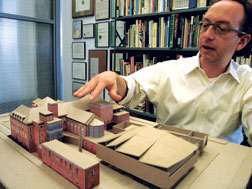Architect Alexander Gorlin has been possessed with model mania for 45 years. Beginning at age seven, he would wile away the hours by filling the floor of his parents' living room with model cities, complete with Matchbox cars and miniature people. Much has changed since Gorlin was a youngster. He has his own architectural practice in New York City, with projects that run the gamut from upscale houses to housing for the poor. But one thing remains the same—Gorlin's model mania.
There are models everywhere in his design studio. Iterations of buildings, punctuated by King Kong and other toy figurines, occupy bookshelves, window sills and nearly every other surface. "I use models almost like sculpture to explore a space," Gorlin says, "but at a very deep level I consider this play and a continuation of childhood activities."
 Photo: James Murdock Cardboard mock-ups are Gorlin's aces in the hole with clients, he says.
|
Never mind that computers have made physical models largely unnecessary. The cardboard mock-up, with its satisfying tactile properties, remains Gorlin's signature skill and his trump card in convincing clients to buy into a design. "As long as people have bodies, they can relate to miniatures," he says.
This much was evident on Thursday afternoon, June 26, during a meeting with representatives of a New York City public high school. The clients were expecting to see three schemes for a 45,000-sq-ft addition for athletics and the arts, which they would eventually present to city authorities for approval and funding. Instead, Gorlin unveiled a model of just one concept.
"I felt this was the right answer for this site," he said, because it met the code requirements, resolved an existing circulation problem and provided opportunities for the surrounding neighborhood to share the facilities.
The school principal liked the scheme. She was clearly impressed by a new swimming pool that was located below grade but day lit by a band of street-level clerestory windows. "It's a dream," she said at the meeting.
 Photo: Alex Gorlin Boy Gorlin and models.
|
For the meeting, Gorlin had prepared three roof treatments: a flat deck with a jogging track and two others, whose slopes reinterpreted the existing building's gables. The principal swapped one roof for another, satisfied with the result. There was plenty of time to decide on a final scheme; more important, she felt so confident about Gorlin's concept that she anticipated presenting it at the next meeting of the school construction authority.
Building support for a design, occupies a large percentage of Gorlin's time. "Be sure to call it a 'community center,' because that makes it about the neighborhood, not just the school," he advised the principal.
Effective People
Gorlin learned the art of "seducing" clients from I.M. Pei, for whom he worked during the 1980s. "Pei's body language was always the opposite of what he was saying. He'd nod his head and smile as he said, 'That's not what we're going to do.'" Gorlin reserves this tactic for critical junctures; most interactions are marked by his Woody Allen-like wit. "I'm a psychologist, psychiatrist, political diplomat and strategist," he says. "For this job you need all the things that are in those airport self-help books: you know, 'The Seven Habits of Effective People.'"
Gorlin began that same Thursday, for instance, by meeting with another client, a nursery school director. The project was in early schematics intended only to help form a budget. But the director's attention turned to specific details: would the children's cubbies be located inside classrooms or the hallway; and was there enough storage space for strollers? Gorlin scribbled notes and improvised solutions directly on the floor plans.
He later observed, "She's just a special interest group within the bigger project, but she was very happy because her needs were being heard."
 Photo: James Murdock  Photo: Alex Gorlin Architects  Photo: Michael Moran All projects get modeled, from modest modular to high-rises.
|
The day ended with Gorlin interviewing two candidates for marketing director of his firm. During a 20-minute gap between interviews, he and two other architects reviewed construction photos to see how the finishes looked at a house they had designed in the Hamptons.
Reflecting on his schedule, Gorlin says: "It's like Robert Venturi once said: you spend only one-tenth of your day designing. The rest ofthe time you're in meetings or on the phone."
If Gorlin's time is unevenly split between meetings and design, he consciously pursues a balanced approach to the type of jobs he takes. It's graphically illustrated by his models: a mansion in Houston rests above a mock-up of the Nehemiah Spring Creek Prefabricated Housing, anaffordable complex for first-time buyers in Brooklyn, N.Y., that, at 700 units, is one of the largest such developments in the city's recent history. Built to the exact same scale, the mansion model occupies nearly as much area as a block of nine model town houses.
Gorlin describes Spring Creek as "karmic balance" to his high-end residential work. A Taoist-tinged phrase is apt: Gorlin has walked a path between extremes throughout his career. A Classicist while earning his architecture degree at Cooper Union in New York City, he later became a Modernist. He left the Yale University School of Architecture, where he taught from 1980 to 1992, to grow his practice, but still finds time to write booksand articles.
And though Gorlin scores jobs through well-connected clients, including the wife of Condé Nast publisher S.I. Newhouse and architect Daniel Libeskind, he also relies on cold-calling. Despite a healthy ego, Gorlinis not above humility. In the days following Sept. 11, 2001, he penned a harshletter to the editor of McGraw-Hill Construction's Architectural Record predicting the end of the era of celebrity architects. Within a year, the phrase "starchitect" was coined and big-name designers seemed more firmly entrenched than ever. "I was wrong about that," he admits.
But post 9/11, something within Gorlin himself changed. He increasingly sought projects like Spring Creek and a 200-unit halfway house for homeless people in the Bronx. He also tackled larger developments, such as a complex of four Bronx high schools, co-designed with Perkins Eastman, New YorkCity.
Noble as they may be, the jobs have been good for Gorlin's bottom line. Since 2001, his staff has doubled in size to 15.
Growth has not stopped the architect from staying involved in all facets of the business—more than he ever imagined as a seven-year-old. But he doesn't mind. "I have some level of ADD," he says, with a laugh, "so I have to jump [around] to keep my day interesting."



Post a comment to this article
Report Abusive Comment